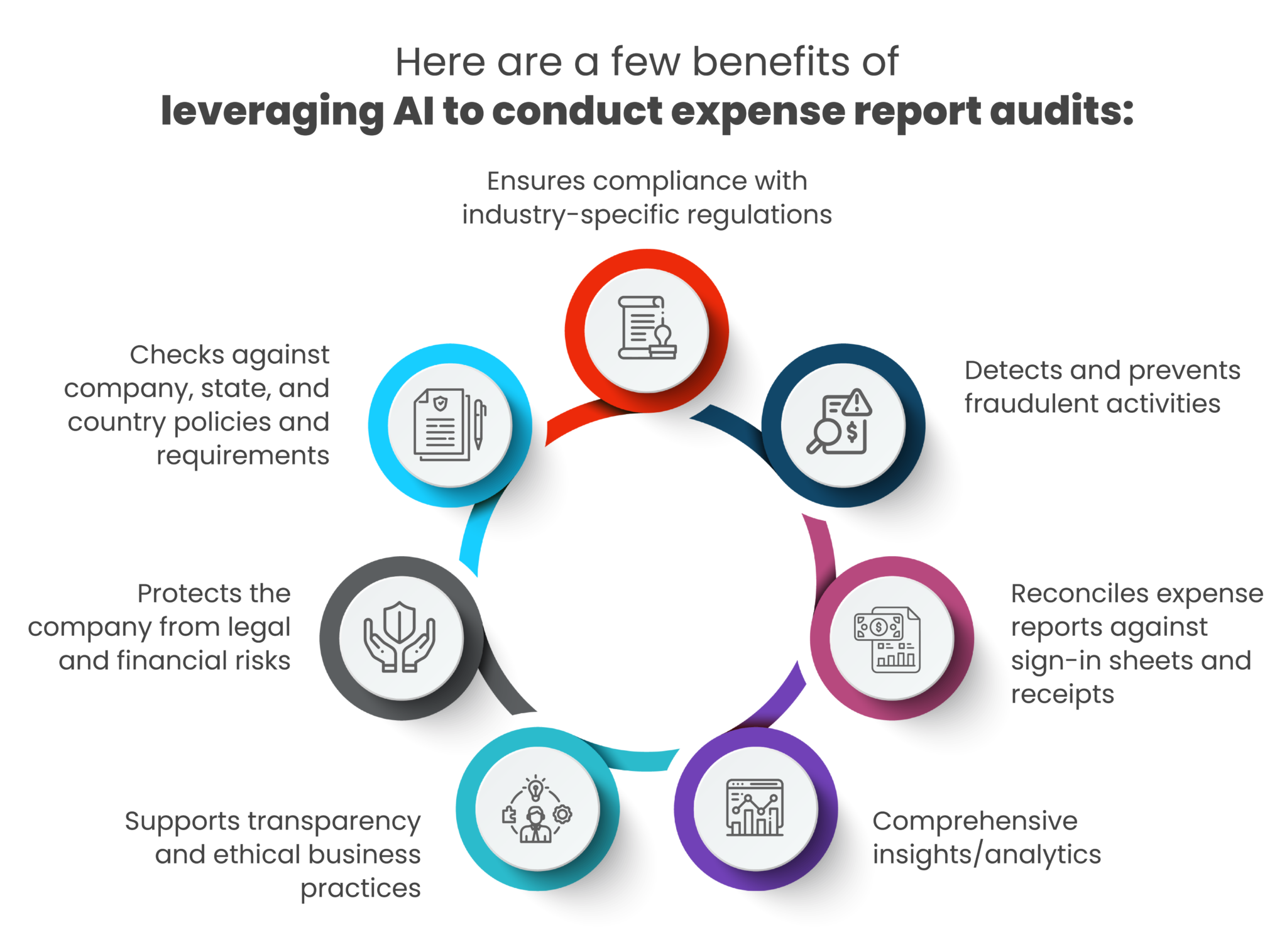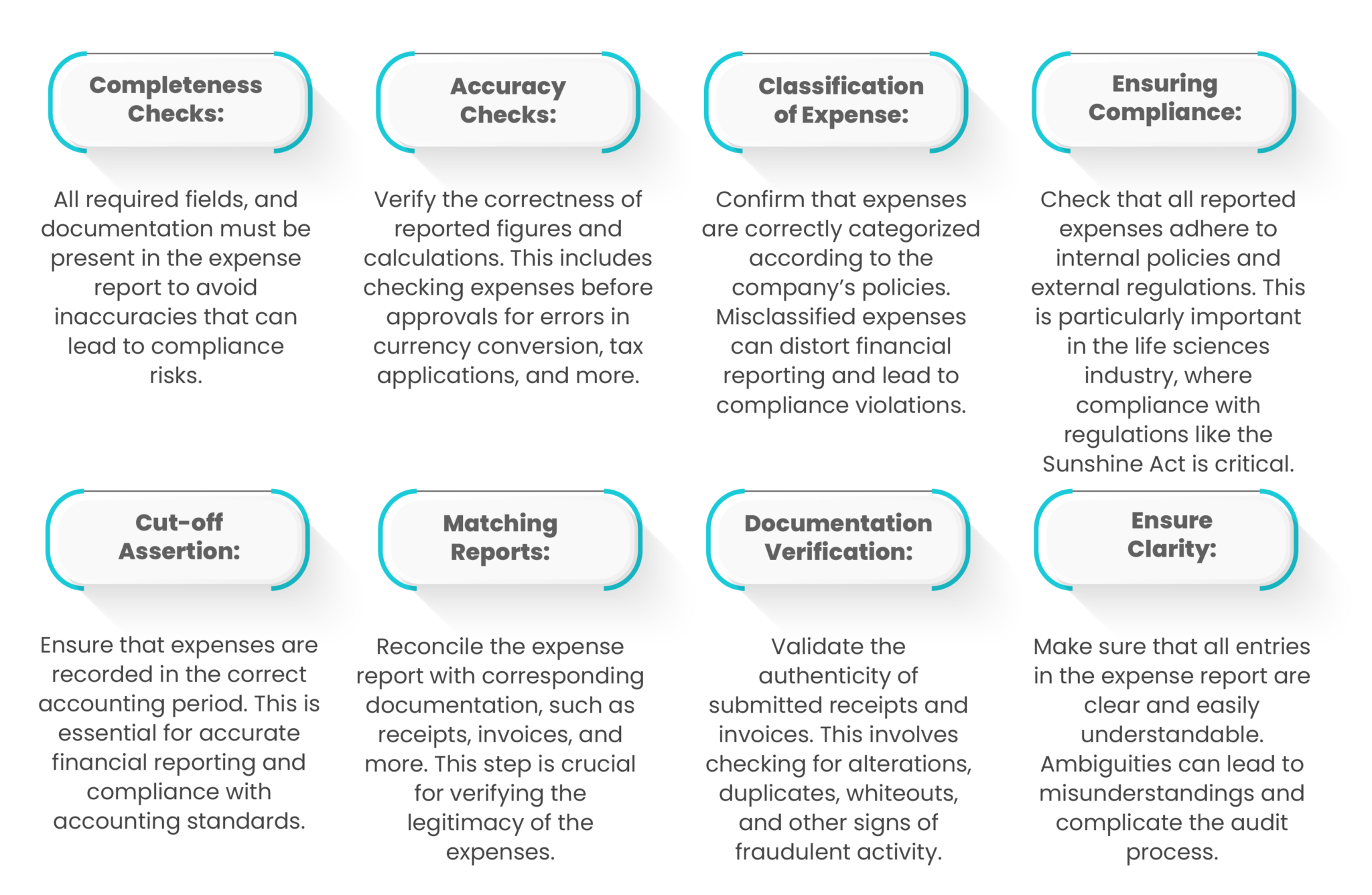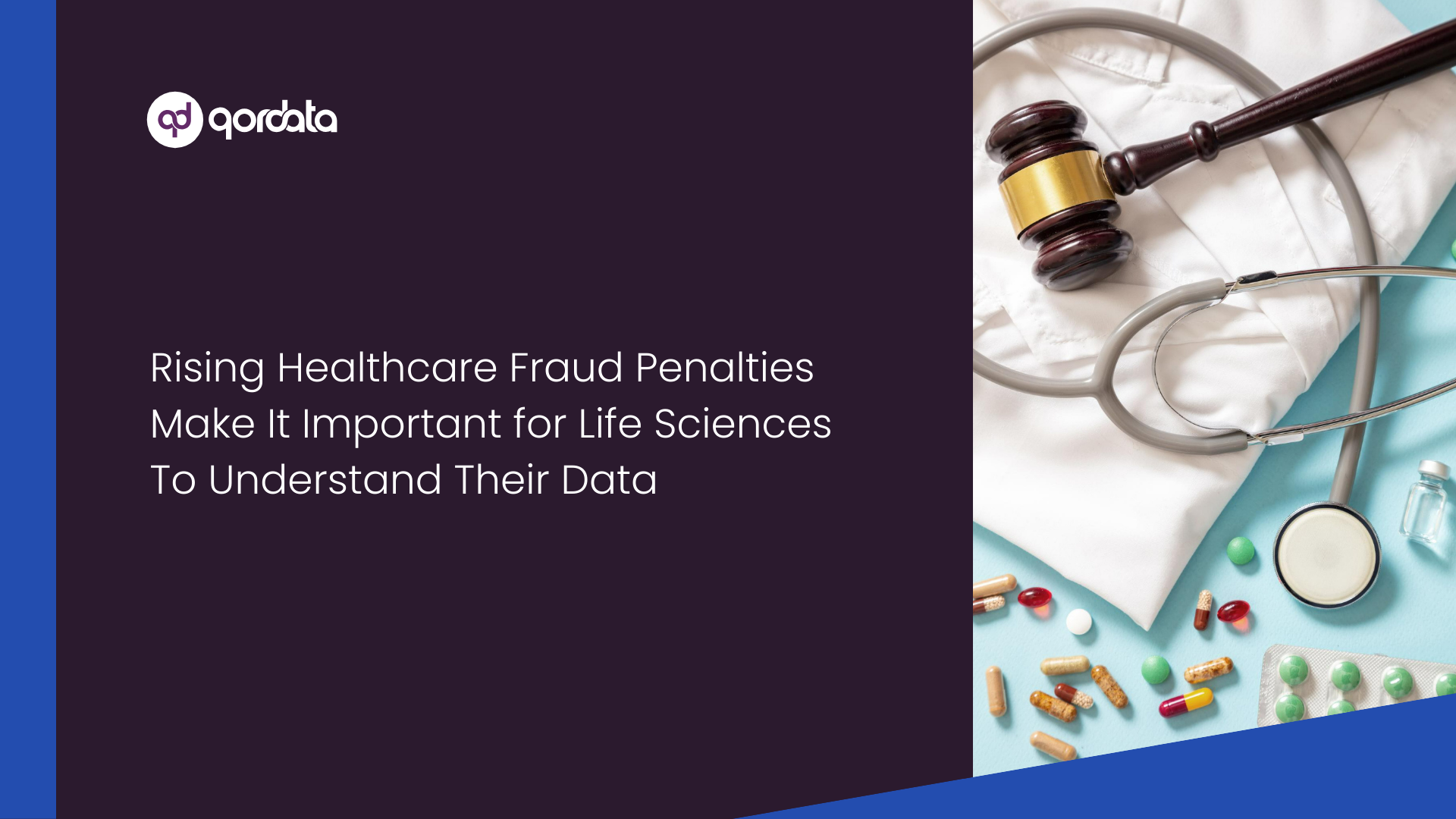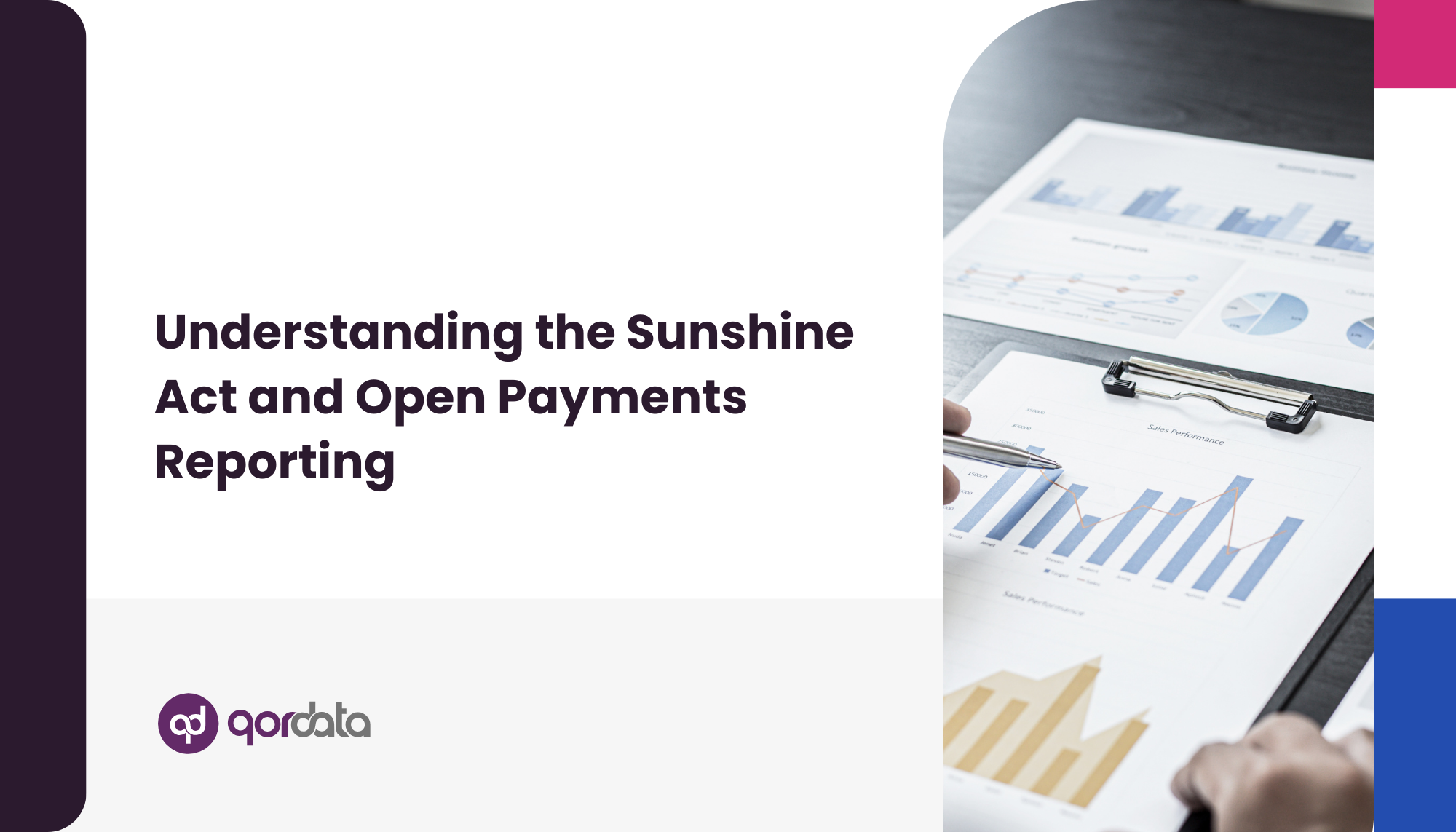Organizations lose an estimated 5% of all revenue to fraud each year. According to the Association of Certified Fraud Examiners (ACFE), this translates to a global loss of $4.5 trillion annually.
The fraud, misconduct, or errors when identified by the regulatory authorities can lead to financial penalties, legal repercussions, and reputational damage, further intensifying the financial impact and undermining stakeholder trust.
This aspect highlights the importance of auditing expense reports for organizations, particularly in the highly regulated life sciences industry.
Expense report audits ensure that all expenses are accurately recorded, compliant with internal policies and external policies, and free from fraud, misconduct, or errors.
In an industry where expenses are subject to strict regulatory oversight, thorough and effective auditing is essential to minimize the risk of non-compliance.
However, the pressure to stay compliant, and ensure adherence to financial regulations is difficult for life sciences companies who are in the race to innovate.
In this guide to auditing expense reports, we will explore the importance of expense audits, the challenges they present, and the best practices for conducting them effectively.
What Is an Expense Report Audit?
An expense report audit is a systematic audit process of reviewing and verifying expense reports submitted by employees.
The goal is to ensure that all reported expenses are accurate, legitimate, and in compliance with company policies, industry standards, and applicable rules and regulations.
This involves cross-checking receipts, verifying the appropriateness of the expenses, and identifying any outliers, unauthorized expenses, discrepancies, and more.
In the life sciences industry, where financial integrity and regulatory compliance are of utmost importance, conducting regular expense audits has proven to ensure that expenses are in line with regulations and guidelines.
Why Is Auditing Expense Reports Important?
Auditing expense reports is essential for several reasons. It ensures that all expenses are properly documented and aligned with the company’s expense policies.
This helps prevent fraud and financial mismanagement, protecting the organization’s financial health.
Internal or external financial audits allow organizations and auditors to understand spending patterns and anomalies in their expense data, and identify expenses that deviate from established policies, guidelines, or thresholds.
Moreover, efficient audits promote compliance with industry-specific regulations, such as the Open Payments Sunshine Act, which requires life sciences companies to report Transfers of value (ToVs), or payments made to healthcare professionals to the Centers for Medicare and Medicaid Services (CMS).
By detecting inconsistencies and addressing discrepancies early, companies can focus their attention on high-risk transactions, avoiding regulatory scrutiny and penalties while ensuring ethical business practices.
Here are a few benefits of leveraging AI to conduct expense report audits:
What Makes Auditing Expense Reports Challenging?
Several factors contribute to the challenges faced by auditors as they track and verify expenses. Let us explore some of the challenges:
1. Managing Bulk Reports
Life sciences companies often deal with a large volume of expense reports due to the nature of their operations, including sales activities, clinical trials, HCP interactions, and other types of expenses.
Managing and auditing such a large number of reports can be overwhelming, leading to potential oversights and errors such as duplicate expense reports, non-policy-compliant expenses, and more.
This challenge is compounded by the need to audit each report thoroughly, ensuring that all expense transactions are legitimate and compliant.
2. Complicated Travel and Expense Policies
The life sciences industry is governed by complex travel and expense policies that vary by region and are influenced by regulatory requirements.
These policies may include specific rules regarding interactions with healthcare professionals, travel for clinical trials, and sponsorships.
Auditors must navigate these complex policies to ensure that all expenses are compliant, which can be a time-consuming and complex process involving comprehensive travel expense audits to ensure compliance.
3. Difficulty Reconciling Reports with Supporting Documents
Ensuring that all expenses are backed by appropriate documentation, such as receipts and invoices, is an important aspect of the expense audit process.
However, reconciling these documents with the expenses filed or reported by the employees can be challenging, especially when dealing with incomplete or inconsistent records.
The difficulty in auditing expense reports is often amplified by the volume of documentation required and the need to verify and validate the legitimacy of each claim.
4. Inaccurate Data Extraction from Receipts
Manual data entry and extraction from receipts can lead to errors.
These inaccuracies can compromise the integrity of the audit process, resulting in incorrect financial reporting, breach of spending limits, and potential compliance issues.
The challenge is to ensure that all data is accurately captured and reflected in the expense reports.
However, the manual process of capturing travel & expense data usually results in inaccuracies, increased administrative burden, and compliance risks.
5. Inability to Detect Risk Patterns in Expense Data
Identifying risk patterns, such as unusual spending patterns or potential fraud, requires sophisticated analysis and analytical capabilities.
Traditional auditing methods may not be sufficient to detect these patterns, leaving the company vulnerable to financial and compliance risks.
The challenge lies in implementing advanced analytical tools such as qordata’s AI-powered Expense Monitoring & Auditing Solution that can uncover suspicious spending patterns, conduct a 100% audit of expense data, provide actionable insights, and more.
6. Time-Consuming Process
Manual auditing is often labor-intensive and time-consuming. This leads to delays in the expense audit process, increasing the risk of errors and making it difficult to keep up with the pace of business.
The time-consuming nature of manual auditing also limits the ability to conduct thorough reviews of expense data.
Auditors take a sample of expense data, run a few checks to determine accuracy, and then move forward.
This approach potentially allows fraudulent or non-compliant expenses to go unnoticed.
7. Constantly Increasing Expense Volume
As life sciences companies grow and expand their operations, the volume of expenses also increases. This puts additional pressure on manual auditing processes, requiring more resources and time to maintain the same level of scrutiny if it is being carried out manually.
The challenge is to scale auditing processes effectively while ensuring that all expenses are thoroughly reviewed and compliant with regulations.
8. Challenges with Global Expense Management
For companies operating globally, managing and auditing expenses across different jurisdictions is challenging. This includes adhering to various regulations, dealing with multiple currencies, and ensuring consistent application of policies across regions.
Global expense management requires a robust expense auditing framework that can adapt to such complexities while maintaining compliance with local and international regulations.
Expense Report Audit Checklist
An effective expense report audit checklist involves a comprehensive review process that ensures all expenses are accurate, compliant, and well-documented.
Below is a checklist that can help streamline the audit process:
- Completeness Checks: All required fields, and documentation must be present in the expense report to avoid inaccuracies that can lead to compliance risks.
How to Identify Fraud & Errors in Expense Reports
Auditors need to be vigilant in detecting common types of fraud and errors, such as inflated claims, falsified documents, and duplicate entries or submissions.
An advanced AI-driven expense auditing tool combined with a keen eye for detail can help identify these red flags early on, preventing financial losses and legal penalties.
1. Inflated Claims
Inflated claims occur when an employee exaggerates the cost of an expense to receive a higher reimbursement.
This can be difficult to detect, especially if the inflation is small. Auditors should compare reported expenses with market rates and look for inconsistencies.
2. Whiteouts
Whiteouts involve the use of correction fluid to alter the details on a receipt or invoice.
This can be a sign of fraudulent activity, such as changing the amount of an expense.
Auditors should closely examine documents for any signs of tampering. Machine learning algorithms can be trained to identify patterns and anomalies in expense data.
AI can flag unusual spending patterns, duplicate expenses, expenses that deviate from established guidelines or thresholds, or detect inconsistencies in signatures, text, or formatting that may indicate the use of correction fluid.
3. Document Verification
Document verification is the process of checking the authenticity of submitted receipts and invoices.
This includes confirming that the documents are genuine, match the reported expenses, and have not been altered. Verification can help identify forged or duplicate documents.=
4. Incorrect Expenses
Incorrect expenses refer to items not eligible for reimbursement according to company policies.
This can include personal expenses, unauthorized purchases, or expenses that exceed policy limits. Auditors should cross-check expenses against the company’s approved list.
5. False Claims
False claims involve reporting expenses that were never incurred. This type of fraud is often premeditated and can be difficult to detect without thorough auditing and cross-referencing with supporting documentation.
6. Duplicate Bills
Duplicate bills occur when an employee submits the same expense multiple times, either intentionally or unintentionally.
Auditors should use software tools to detect duplicates and ensure that each expense is only reimbursed once.
How qordata’s Expense Monitoring & Auditing Helps with Auditing Expense Reports
qordata’s Expense Monitoring & Auditing solution enables life sciences companies to conduct a 100% audit of expense reports within minutes.
The solution leverages AI, machine learning, and other advanced technologies to detect unusual spending patterns, duplicate expenses, and expenses that deviate from established guidelines or thresholds and whiteouts.
It also detects inconsistencies in signatures, text, or formatting that may indicate the use of correction fluid, enabling auditors to focus their attention on high-risk transactions.
The platform integrates with existing workflow systems and SAP Concur, enabling automated data extraction to streamline the auditing process and enhance accuracy.
Book a demo to see how our Expense Monitoring & Auditing solution can help you simplify your expense reporting process, manage risk remediations, and stay compliant.
Why Use qordata’s Expense Monitoring & Auditing Solution?
qordata’s Expense Monitoring & Auditing solution offers a wide range of features that enhance the expense monitoring and auditing process of life sciences companies.
- Pattern and Anomaly Detection: Machine learning algorithms identify patterns and anomalies in expense data, flagging unusual spending, duplicate expenses, and deviations from guidelines.
- Advanced Technologies: OCR & computer vision to convert meal receipts, boarding passes, sign-in sheets, and other expense receipts into machine-readable text.
- Inconsistency Detection: AI detects inconsistencies in signatures, text, or formatting that may indicate tampering, helping auditors focus on high-risk transactions.
- Third-Party Integrations: Offers integration with existing workflow systems and financial software platforms such as SAP Concur streamlining the audit process and enabling real-time monitoring and analysis.
- Fraud Detection: AI analyzes expense data to identify suspicious activities or behaviors, applying predictive analytics to detect unauthorized expenses or inflated invoices.
- Automation: An automated process of expense checks and validations ensures alignment with regulations and guidelines, minimizing the risk of non-compliance and avoiding regulatory penalties.
- Risk Remediation Management: The solution enables effective risk management by moving risky representatives and reports to a dedicated workbench, consolidating expense data, ensuring compliance, and simplifying the reporting process.
The Five Best Practices for Auditing Expenses
1. Conduct the Expense Audit Before Approval
Conducting a pre-expense audit before expenses are approved for reimbursement ensures that any discrepancies or non-compliant expenses are identified and addressed early.
This proactive approach minimizes the risk of financial loss and ensures compliance with company policies and regulations.
2. Audit All Your Expenses
Auditing all expenses, rather than just a sample, ensures that no fraudulent or erroneous claims go unnoticed.
This comprehensive approach is particularly important in industries like life sciences, where the stakes are high, and even small discrepancies can lead to significant compliance issues.
3. Leverage Advanced Technologies
Leveraging advanced technologies, such as AI, machine learning & OCR, can enhance the efficiency and accuracy of the auditing process.
Expense auditing solutions powered by such technologies can help identify patterns, detect anomalies, and automate repetitive tasks, allowing auditors to focus on more complex and strategic activities.
4. Set Systematic Reviews
Establishing a routine for systematic reviews of expense reports ensures ongoing compliance and helps identify trends or recurring issues that may require policy adjustments.
Regular audits contribute to a culture of continuous improvement and strengthen financial controls.
5. Use Data Wisely
Analyzing the data collected from expense audits can provide valuable insights into spending behaviors, potential compliance risks, and areas for cost savings.
A data-driven approach allows organizations to optimize their expense management strategies and align them with broader organizational goals.
Conclusion
Auditing expense reports is an important function for life sciences companies, ensuring financial accuracy, regulatory compliance, and the prevention of fraud.
By understanding the challenges involved, implementing best practices, and leveraging advanced technologies like qordata’s Expense Monitoring & Auditing solution, organizations can enhance their auditing processes and protect themselves from financial and compliance risks.
Effective auditing not only safeguards the company’s financial integrity but also contributes to a culture of transparency and ethical business practices.
Other Relevant Reads:





